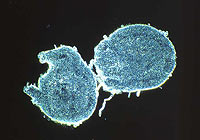
Dark-field photo of Frankia vesicle clusters (single plant cells filled with the filamentous organism) that have broken free from nodules in the plant Coriaria arborea.
This project will elucidate the genome of a Frankia sp. strain that represents one of three lineages (Cluster 2) within the genus. The strain is an obligate symbiont living in plant tissue. Genome sequences of close relatives who are not “obligate” have recently become available and will be used for comparative genomics. Frankia sp. strains are filamentous actinobacteria that form nitrogen-fixing root nodules on woody trees and shrubs in a symbiosis termed “actinorhizal”. In the aggregate, frankiae form the major nitrogen-fixing symbioses in the temperate forests of the world and grow well on marginal soils. The plants are used for remediating stressed or contaminated soils, and they are potential sources of biomass for energy generation and carbon sequestration.
The availability of a Cluster 2 Frankia genome sequence will provide a major tool for studying the free-living and symbiotic lifestyles of Frankia. Cluster 2 strains are basal to the Frankiaceae, so a study of the genome will help pinpoint genes concerned with symbiosis, stress responses, and secondary metabolite production, and will provide an assessment of the evolutionary trajectory followed by various Frankia clades as they co-adapted to new environments with their hosts. Access to this Frankia genome will move the field forward by several orders of magnitude during the next decade than could otherwise be done.
Principal Investigators: David R. Benson (Univ. of Connecticut), Katharina Pawlowski (Stockholm Univ.), and Alison Berry (Univ. of California, Davis)